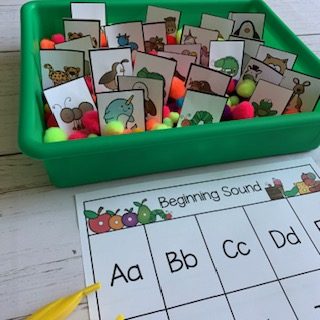Fine Motor Practice in Kindergarten

What is Fine Motor Practice?
Fine motor skills involve the use of small muscles in the hand. Tasks such as gripping and writing with a pencil, cutting with scissors, button a jacket, etc. incorporate a student’s fine motor skills. Unlike gross motor skills, such as crawling, running, and jumping, fine motor skills may not develop naturally. A baby learns to roll over, sit up, crawl, and walk without much intention. Fine Motor skills are not practiced as thoroughly. Because of this, many students enter preschool and kindergarten without having strengthened the hand muscles needed to complete many tasks!
Why is Fine Motor Work Important?
These skills affect both daily and academic tasks. Buttoning and zipping clothes, or tying shoes, rely on a student’s finger and hand strength. Writing, coloring and cutting also incorporate hand muscles. If students enter your classroom without the dexterity needed to complete these tasks, they will not learn them without ample time to practice! Kindergarten is one of the last seasons in a child’s life where fine motor work can be worked into the classroom. After this year, the academic standards become more rigorous. This makes it difficult for teachers to devote time to this work.
What Fine Motor Activities Can I Do?
Some of my favorite activities include:
Tweezers: Students lift small items by pinching and lifting with tweezers.
Sponges: Filling and squeezing out sponges is great muscle practice!
Spray Bottles: Spraying water out of bottles builds hand muscles.
Play-Doh: Rolling, pinching, and twisting play-doh is a great muscle work out!
Sensory Bins
If you read the list above and thought to yourself: How can I work those activities in, while also teaching skills?, I have a simple answer for you. Sensory bins! Sensory bins are the perfect way to tie in fine motor skills, while also practicing academic standards.
A sensory bin is typically a large tub or bin filled with items that will stimulate the senses. On top of that, students use tools to engage with the items. Students use tweezers or spatulas to lift items out of a sensory bin, building muscle strength. Then, after reading task cards pulled out of the bin, they write answers down. Sensory bins can include water, play-doh, clay, or any other sensory-inducing item you have!

I have a YEAR-LONG bundle of sensory bins to make it easy for you to include them in your classroom! These sensory bins are seasonal, and focus on academic skills kindergarteners need. Grab the one resource you’ll need all year to make sensory bins word in your room HERE! And, read about more hands-on learning activities at this post!





